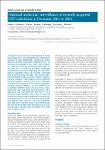National molecular surveillance of recently acquired HIV infections in Germany, 2013 to 2014
Hauser, Andrea
Hofmann, Alexandra
Hanke, Kirsten
Bremer, Viviane
Bartmeyer, Barbara
Kücherer, Claudia
Bannert, Norbert
To enable an up-to-date molecular analysis of human immunodeficiency virus (HIV) genotypes circulating in Germany we have established a surveillance system based on recently acquired HIV infections. New HIV infections are reported to the Robert Koch Institute as a statutory duty for anonymous notification. In 2013 and 2014, a dried serum spot (DSS) sample was received from 6,371 newly diagnosed HIV-cases; their analysis suggested that 1,797 samples originated from a recent infection. Of these, 809 were successfully genotyped in the pol region to identify transmitted drug resistance (TDR) mutations and to determine the HIV-1 subtype. Total TDR was 10.8%, comprising 4.3% with mono-resistance to nucleoside reverse transcriptase inhibitors (NRTIs), 2.6% to non-NRTIs, 3.0% to protease inhibitors and 0.6% and 0.2%, respectively, with dual- and triple-class resistances. HIV-1 subtype B was most prevalent with 77.0%. Non-B infections were identified more often in men and women with heterosexual transmission compared with intravenous drug users or men who have sex with men (79% and 76%, 33%, 12%; all p
Dateien zu dieser Publikation
Keine Lizenzangabe

